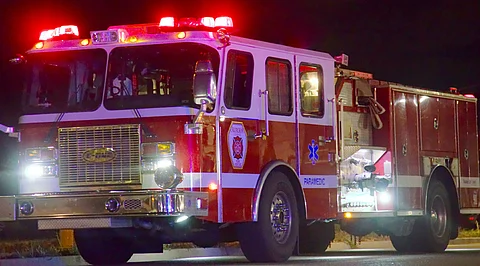

When it comes to emergencies, seconds count. Be it a fire, a medical emergency or a threat to public safety, the time it takes for first responders to get to their destination can mean the difference between life and death. The demand for quick and dependable response capabilities in emergencies has spawned technologies that enhance mobility and efficiency. Miovision is equipped with emergency vehicle preemption (EVP), among others, that fast-tracks emergency response times through adjusted real-time traffic signals.
The EVP systems, such as Miovision’s Opticom Cloud, work by enabling emergency vehicles to talk directly to traffic signals. When the system senses an emergency vehicle outfitted with alerting equipment coming to an intersection, it temporarily suspends the standard signal cycles to provide an unobstructed channel of travel. This is usually accomplished by extending the blueness of the green light or turning it into a red light blue (for the incoming direction).
Not only does the ability to control traffic lights mean that unwarranted stopping is avoided, but travel times are lessened and--arguably the most critical point--accidents at intersections can be reduced. In general, intersections are some of the most dangerous areas of any road, particularly when cars are zipping through them at a high clip because of an emergency call. Through a decrease in these hazards, EVP ensures the safety of not only first responders but also the general public.
Traditionally, EVP technology has been based on radio communications with a direct line of sight through radio antennas housed at intersections and on board the vehicle. These conventional systems are effective, but have a number of problems:
High Deployment and Maintenance Costs: Dedicated hardware and transmitting equipment must be installed at every intersection and in every emergency vehicle, respectively.
Scalability: It can be challenging and costly to scale EVP to cover entire large urban centers or even fast-growing cities.
Hardware Failures: Physical hardware deteriorates over time and needs to be maintained, and may go offline unexpectedly.
Limited Data Access: Legacy systems have little to no analytic functionality, limiting agencies' ability to monitor performance or detect areas for improvement.
Cloud-based EVP systems are a fundamental departure from conventional practice. Rather than relying only on roadside infrastructure and radio-based communications, these systems utilize GPS, wireless networking, and cloud computing to provide more flexible and affordable solutions.
Some of the most significant benefits are:
Real-time GPS-enabled communication: With cloud-based EVP platforms, GPS is used to monitor emergency vehicles in real time, so that signal changes are more accurately timed with the vehicles and the traffic environment corrected to match real vehicle movement.
Remote Management Options: The system can be monitored, configured and adjusted by traffic and emergency management operatives from a distance. This centralized but remote control allows considerable time and cost savings in on-site maintenance.
Scalable Infrastructure: Without the need for hardware at each intersection, cities can roll out EVP Infrastructure much quicker with less investment.
Reduced Long-Term Maintenance Costs: With less reliance on physical infrastructure, these solutions mean less manual troubleshooting, less equipment being replaced in the field, and fewer truck rolls.
Analyzing Data and Performance: Improved dashboards with real-time system performance analytics allow agencies to measure improvements, optimize routes, and allocate resources more effectively.
Opticom Cloud from Miovision is one example of a successful cloud-based EVP. Unlike conventional systems that need special in-vehicle transmitters, Opticom Cloud utilizes GPS and cloud connectivity to deliver effortless EVP. Regular vehicles with conventional GPS can communicate with connected lights without any special hardware.
The solution features a uniform, unified management dashboard that provides agencies with oversight of system operations and performance statistics. With this information, departments can better understand where and how their resources are being deployed, identify inefficiencies, and make data-driven decisions to improve response more generally.
This is a compelling cloud-based EVP application being used in San Rafael, California. The city has installed Miovision’s Opticom system at 53 intersections. That speed-up translated to the city claiming that it saw a 25% decrease in response times to emergencies. This upgrade is a real public-safety upgrade, helping emergency personnel get between people in distress and those hoping to lend a hand.
Cloud-based EVP systems are not only technology updates—they have become a part of the public safety infrastructure. With the growth of the number of city dwellers and an increase in traffic congestion, one would want to have more efficient means of prioritizing urgent vehicles. Cities that adopt scalable, evidence-based traffic management systems today can help to meet the challenges of tomorrow.
By adopting cloud-based EVP solutions, cities can help ensure that antiquated traffic systems never slow down responders and that help can reach wherever and whenever it is needed most.
